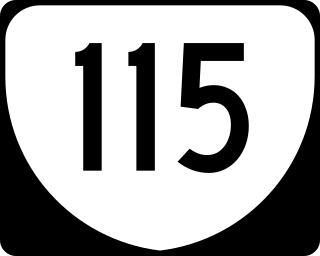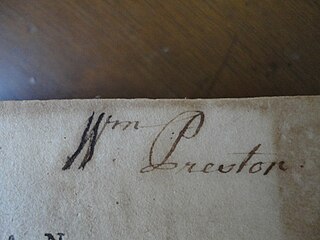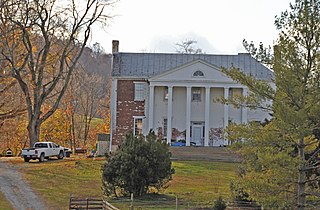Related Research Articles

Botetourt County is a US county that lies in the Roanoke Region of the Commonwealth of Virginia. Located in the mountainous portion of the state, the county is bordered by two major ranges, the Blue Ridge Mountains and the Appalachian Mountains.

United States Colored Troops (USCT) were Union Army regiments during the American Civil War that primarily comprised African Americans, with soldiers from other ethnic groups also serving in USCT units. Established in response to a demand for more units from Union Army commanders, by the end of the war in 1865 USCT regiments, which numbered 175 in total, constituted about one-tenth of the manpower of the army. Approximately 20% of USCT soldiers were killed in action or died of disease and other causes, a rate about 35% higher than that of white Union troops. Numerous USCT soldiers fought with distinction, with 16 receiving the Medal of Honor. The USCT regiments were precursors to the Buffalo Soldier units which fought in the American Indian Wars.
William Christian was a military officer, planter and politician from the western part of the Colony of Virginia. He represented Fincastle County in the House of Burgesses and as relations with Britain soured, signed the Fincastle Resolutions. He later represented western Virginia in the Virginia Senate and founded Fort William, as well as helped negotiate the Treaty of Long Island of the Holston, which made peace between the Overmountain Men and Cherokees in 1777. He was killed in 1786 at the outset of the Northwest Indian War, leading an expedition against Native Americans near what is now Jeffersonville, Indiana.
Fincastle County, Virginia, was created by act of the Virginia General Assembly April 8, 1772 from Botetourt County. As colonial government considered Virginia's western extent to be the Mississippi River, that became Fincastle's western limit. Its eastern boundary was essentially the New River, thus dividing Botetourt County from north to south. The new county encompassed all of present-day Kentucky, plus southwestern West Virginia and a slice of Virginia's western "tail". Although no county seat was designated by the act creating the county, the colonial governor ordered it to be placed at the "Lead Mines" of present-day Wythe County; the community of Austinville later developed there.

State Route 115 is a primary state highway in the U.S. state of Virginia. Known for most of its length as Plantation Road, the state highway runs 6.00 miles (9.66 km) from U.S. Route 221, US 460, and US 220 Alternate in Roanoke north to Interstate 81 (I-81) and US 220 near Hollins.
Colonel William Fleming was an American physician, soldier, politician, and planter who served as a local justice of the peace in the mountains of southwestern Virginia and Kentucky, as well as in the Senate of Virginia and briefly acted as the Governor of Virginia during the American Revolutionary War.
The Roanoke Region is the area of the Commonwealth of Virginia surrounding the city of Roanoke. Its usage may refer to the metropolitan statistical area or the Roanoke Valley, but it sometimes includes areas in the Allegheny Mountains and New River Valley which includes Alleghany County, Montgomery County, Covington, Clifton Forge, Blacksburg, Christiansburg, and Radford. Bedford County and Floyd County are sometimes included as part of the region.

The 28th Virginia Infantry Regiment was an infantry regiment raised in Virginia for service in the Confederate States Army during the American Civil War. It fought mostly with the Army of Northern Virginia. The 28th Virginia completed its organization at Lynchburg, Virginia, in June, 1861. Its members were raised in the counties of Botetourt, Craig, Bedford, Campbell, and Roanoke.
Botetourt Springs is a mineral spring and was a historical settlement on the border of Roanoke County, Virginia and Botetourt County, Virginia, United States. The spring is located 12 mi (19 km) from Fincastle. Botetourt Springs was originally settled in the mid-18th century, growing as a mineral spring resort during the summer, especially after the 1820s.

Colonel William Preston was an Irish-born American military officer, planter and politician. He played a crucial role in surveying and developing the Southern Colonies, exerted great influence in the colonial affairs of his time, owned numerous slaves on his plantation, and founded a dynasty whose progeny would supply leaders of the South for nearly a century. He served in the House of Burgesses and was a colonel in the Virginia militia during the American Revolutionary War. He was one of the fifteen signatories of the Fincastle Resolutions. Preston was also a founding trustee of Liberty Hall when it was transformed into a college in 1776.

Lauderdale is a historic home located near Buchanan, Botetourt County, Virginia. Lauderdale takes its name from the eighteenth century owner of the property, James Lauderdale Sr. Lauderdale purchased 366 acres on Looney Mill Creek in 1749. By the early 1780s, he owned over a thousand acres in Botetourt County, and in 1785 he was listed as the owner of a dwelling and three other buildings. The home Lauderdale was built in 1790 by James Lauderdale Sr. Lauderdale Sr. settled in the area in 1730, when the region was still in the possession of the Indians. The mansion 'Lauderdale' was built near a spring, near which it is said that Lauderdale shot and killed an Indian during an attack on his home. The plantation consisted of 1200 acres, Lauderdale is one of the largest houses in Botetourt. There are thirty rooms within its walls. The high ceilings and hand carved woodwork of the immense hallway, library, and drawing room make it one of the handsomest houses is Virginia. The bricks on its walls were made by slaves on the place. In 1796, Lauderdale sold 444 acres, including his residence to Col. Henry Bowyer. Most references to Lauderdale incorrectly show the date of its construction as 1821, yet the Botetourt County Deed Book VI, page 36, clearly shows the subsequent owner of the mansion from Lauderdale's son, James Lauderdale Jr., a Col. Henry Bowyer, having purchased the home in 1796.

George Plater Tayloe was a Virginia businessman, soldier and legislator who also served as one of the original trustees of Hollins University.
Fleming Bowyer Miller was an American lawyer and politician who represented Botetourt County, Virginia in both houses of the Virginia General Assembly during three decades, including in the Virginia Senate following the American Civil War. He also served in the Virginia Constitutional Convention of 1829–1830, Virginia Constitutional Convention of 1850 and the Virginia Secession Convention of 1861.
George William Newman Fulton (1834–1894) was a noted potter who worked in Allegheny County, Virginia and in Fincastle, Virginia.
John Thomas Anderson was a nineteenth-century American lawyer, iron manufacturer and politician who served in both chambers of the Virginia General Assembly, representing Botetourt and nearby counties.
The First Baptist Church of Fincastle, Virginia was started in October 1831 by slaves in Fincastle, Virginia in Botetourt County, Virginia.

The 45th United States Colored Infantry was an infantry regiment of the Union Army during the American Civil War.
George Woodson Hansbrough was a Virginia farmer, lawyer and soldier who during his final decade reported opinions issued by the Virginia Supreme Court. During the American Civil War, Hansbrough recruited a company of Confederate States Army volunteers from Taylor County in what became West Virginia during that conflict, and later recruited another company from near Roanoke, Virginia.
Thomas Shanks was an American slave owner and politician who won three elections to represent Botetourt County in the Virginia House of Delegates.

William Madison Peyton was a Virginia lawyer, politician and slave owner who began developing what would become the coal country of Virginia and West Virginia in the 1840s. Peyton sympathized with the Confederate States of America and died financially ruined shortly after the war's end.
References
- ↑ Jennings, Ruby Brugh. 1850 Census, Botetourt County, Virginia. St. Louis: Tree Art Publishers, 1976.
- ↑ McCoy, Edwin. 2017. Botetourt County & the War Between the States. Botetourt County Historical Society. Fincastle, Virginia. Page 62.
- ↑ Harvey, Neil. 2017. "A soldier of old, remembered" the Roanoke Times. May 27, 2017.
- ↑ Burton, Charles T. Fincastle, Virginia Past: People with Places. Troutville, Va: C.T. Burton, 1984. Page number not given
- ↑ Ayers, Charles Linard. Civil War Soldiers in Botetourt County Virginia Cemeteries. [Hollins, Va. (915 Hugh Ave., Hollins, 24019-4312)]: [C.L. Ayers], 1996. No page number given.
- ↑ Fincastle Herald. June 4, 1935.
- ↑ FindaGrave.com
- ↑ Rousseau, Heather. 2017. "Sons of Union Veterans of the Civil War honor the memory of Private Pleasant Richardson." Roanoke Times . May 27, 2017.
- ↑ FindaGrave.com